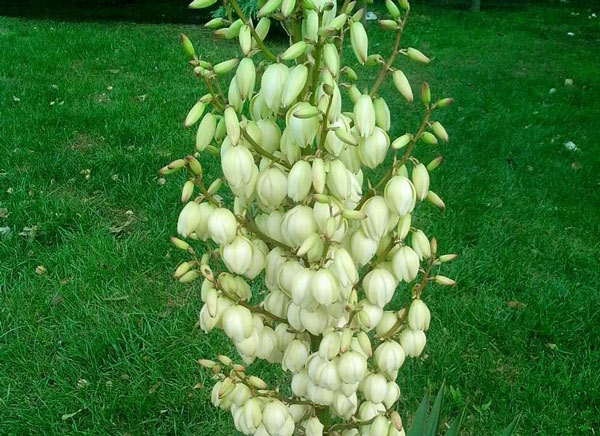Adams Needle Plant (Yucca Filamentosa) Profile
Written by Iris
Dec 15 2021
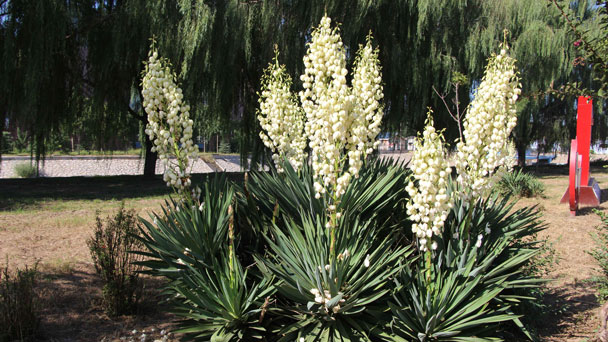
Adams Needle Plant (Yucca filamentosa) is an important building plant in garden design. Adams Needle Plant will grow in areas where irrigation is not convenient and many other types of plants are difficult to grow. New Adams Needle Plants will sprout around the base of the yucca, eventually forming an attractive cluster. Each year Adams Needle Plant shed their lower leaves and slowly grow a trunk.
Adams Needle Plant should only be grown in full sunlight. Adams Needle Plant prefers dry to average moisture levels with very well-drained soil, and will often die in standing water. Adams Needle Plant is considered to be drought-tolerant, and thus makes an ideal choice for a low-water garden or xeriscape application. Adams Needle Plant is not particular as to soil type or pH. Adams Needle Plant is somewhat tolerant of urban pollution.
Read More:
Adams Needle (Yucca Filamentosa) Plant Grow & Care Guide
How to Propagate Adams Needle Plant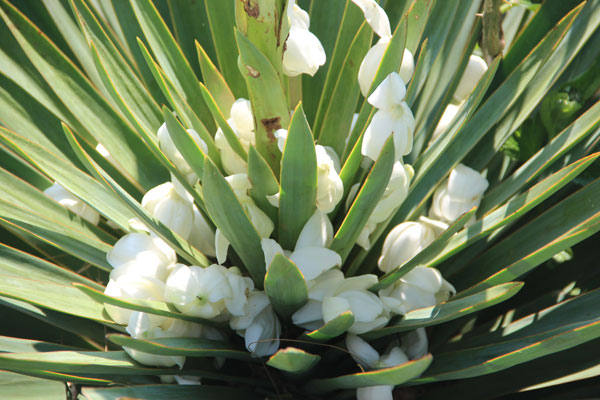
You might be wondering why your Adam’s Needle’s native region is important. Well, if you know where your Adams Needle Plant originally came from, you’ll know which environment conditions it prefers, and with it, knowledge on how to replicate it at home.
With this in mind, the Yucca Filamentosa will be most used to the heat zones in the 5 – 11 region, as the plants hardiness falls between 4a, 4b, 5a, 5b, 6b, 6a, 7a, 7b, 8a, 8b, 9a, 9b, 10b, 10a and the ideal climate zone is between 1, 1A, 1B, 2, 2A, 2B, 3, 3A, 3B, 4, 5, 6, 7, 8, 9, 10, 11, 12, 13, 14, 15, 16, 17, 18, 19, 20, 21, 22, 23, 24.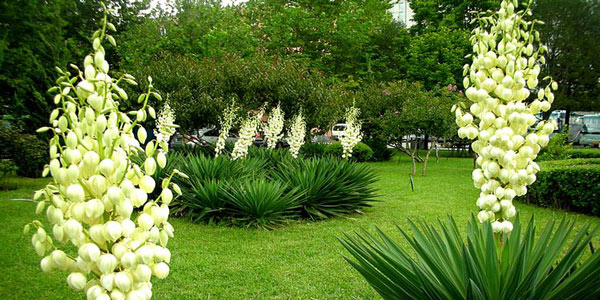
Yucca elata (soap-tree yucca): This tree can reach 15 feet tall. It can be grown in zones 5 to 8
Yucca glauca (soapweed): Not to be confused with soap-tree yucca, this plant is suitable for zones 3 to 10.
Yucca flaccid: This yucca's leaves stand fairly limp while most other yucca plants have rigid leaves; it grows in zones 4 to 10.
Yucca brevifolia: Also known as the Joshua tree of the American Southwest, it is another type of tree-form yucca suitable for zones 6 to 8.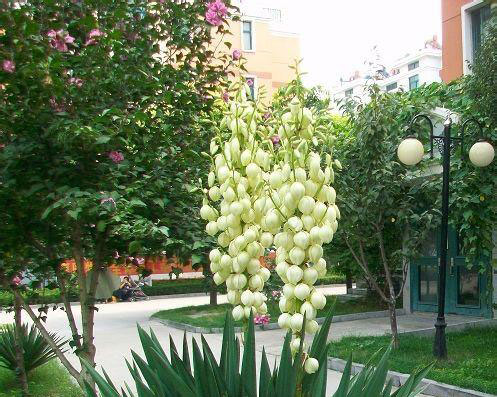
Yucca Filamentosa also needs insecticide regularly to keep slugs and snails at bay as these can damage the plant.
Adams Needle Plant is also prone to mites. This is characterized by speckling on the leaves or the appearance of gray webs.
This can be prevented with miticides, pruning, and soaping with special insecticidal soap.
Fungal diseases can occur in the form of spotted leaves with reddish-orange marks. These should be removed as soon as possible to prevent the disease from spreading to other leaves.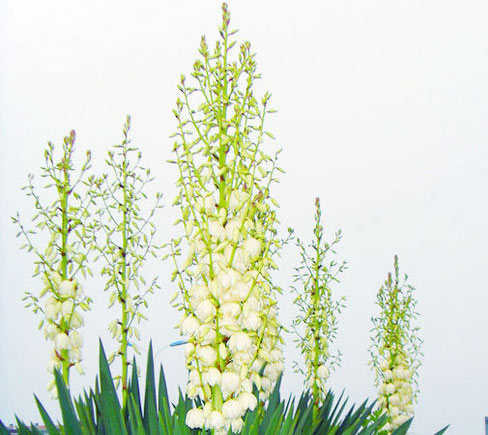
Adams Needle Plant PictureAdams Needle Plant InfoAdams Needle Plant Native HabitsAdams Needle Plant DistributionAdams Needle Plant UsesAdams Needle Plant VarietiesAdams Needle Plant Common Pests/DiseasesAdams Needle Plant Design TipsAdams Needle Plant Companion Plants
Adams Needle Plant Picture
Adams Needle Plant Info
| Botanical Name | Yucca filamentosa |
| Common Names | Adam's needle, needle palm |
| Plant Type | Broadleaf evergreen shrub |
| Mature Size | 4 to 8 feet tall, 2- to 3-foot spread |
| Sun Exposure | Full sun |
| Soil Type | Dry to medium-moisture, well-drained soil |
| Soil pH | 5.5 to 7.5 (acidic to slightly alkaline) |
| Bloom Time | June to July |
Adams Needle Plant Native Habits
Adams Needle Plant will grow to be about 30 inches tall at maturity extending to 5 feet tall with the flowers, with a spread of 3 feet. adams needle Plant tends to fill out right to the ground and therefore doesn't necessarily require facer plants in front. Adams needle plant grows at a medium rate, and under ideal conditions can be expected to live for approximately 20 years.Adams Needle Plant should only be grown in full sunlight. Adams Needle Plant prefers dry to average moisture levels with very well-drained soil, and will often die in standing water. Adams Needle Plant is considered to be drought-tolerant, and thus makes an ideal choice for a low-water garden or xeriscape application. Adams Needle Plant is not particular as to soil type or pH. Adams Needle Plant is somewhat tolerant of urban pollution.
Read More:
Adams Needle (Yucca Filamentosa) Plant Grow & Care Guide
How to Propagate Adams Needle Plant

Adams Needle Plant Distribution
The Adam’s Needle is a plant native to the Long Island and PA and s. to FL and LA. This is why the yucca filamentosa is used to growing in specific regions such as the states in Southeast, Northeast, and the Southwest of the United States.You might be wondering why your Adam’s Needle’s native region is important. Well, if you know where your Adams Needle Plant originally came from, you’ll know which environment conditions it prefers, and with it, knowledge on how to replicate it at home.
With this in mind, the Yucca Filamentosa will be most used to the heat zones in the 5 – 11 region, as the plants hardiness falls between 4a, 4b, 5a, 5b, 6b, 6a, 7a, 7b, 8a, 8b, 9a, 9b, 10b, 10a and the ideal climate zone is between 1, 1A, 1B, 2, 2A, 2B, 3, 3A, 3B, 4, 5, 6, 7, 8, 9, 10, 11, 12, 13, 14, 15, 16, 17, 18, 19, 20, 21, 22, 23, 24.

Adams Needle Plant Uses
The Adams Needle Plant is an impressive specimen plant that fits wonderfully in prairie gardens and gravel beds. They can also be cultivated in vessels. The flowers are popular with bees and butterflies. As a planting partner there are for example pearly everlasting (Anaphalis triplinervis'summer rain'), elephant's ears (Bergenia), baby's breath (Gypsophila), lavender, stonecrop (Sedum) or lamb's ear (Stachys byzantina).Adams Needle Plant Varieties
There are many other types of yucca plants besides Yucca filamentosa, including:Yucca elata (soap-tree yucca): This tree can reach 15 feet tall. It can be grown in zones 5 to 8
Yucca glauca (soapweed): Not to be confused with soap-tree yucca, this plant is suitable for zones 3 to 10.
Yucca flaccid: This yucca's leaves stand fairly limp while most other yucca plants have rigid leaves; it grows in zones 4 to 10.
Yucca brevifolia: Also known as the Joshua tree of the American Southwest, it is another type of tree-form yucca suitable for zones 6 to 8.

Adams Needle Plant Common Pests/Diseases
Too much moisture can cause rust fungus in this Yucca plant. This usually occurs during winter. Prevent this by protecting the plants from heavy winter moisture.Yucca Filamentosa also needs insecticide regularly to keep slugs and snails at bay as these can damage the plant.
Adams Needle Plant is also prone to mites. This is characterized by speckling on the leaves or the appearance of gray webs.
This can be prevented with miticides, pruning, and soaping with special insecticidal soap.
Fungal diseases can occur in the form of spotted leaves with reddish-orange marks. These should be removed as soon as possible to prevent the disease from spreading to other leaves.

Adams Needle Plant Design Tips
Adams Needle Plant makes a fine choice for the outdoor landscape, but it is also well-suited for use in outdoor pots and containers. Because of its height, Adams Needle Plant is often used as a 'thriller' in the 'spiller-thriller-filler' container combination; plant it near the center of the pot, surrounded by smaller plants and those that spill over the edges. Adams Needle Plant is even sizeable enough that it can be grown alone in a suitable container. Note that when grown in a container, Adams Needle Plant may not perform exactly as indicated on the tag - this is to be expected. Also note that when growing plants in outdoor containers and baskets, Adams Needle Plant may require more frequent waterings than they would in the yard or garden.Adams Needle Plant Companion Plants
Adams Needle Plants do well with some other plants beside it. One good companion plant is the Cistus x ‘Brilliancy’, which will pair up nicely with your leafy friend. A nice Rosmarinus officinalis will work well too, so choose whichever you find works best for you.Latest Updated
- Benefits of Bugleweed - 7 Science-backed Health Benefits
- Bugleweed Dangers & Side Effects - Is It Poisonous?
- How to Plant Evergreen Trees - What You Should Know
- When to Plant Evergreens - Grow Guide for Evergreen Trees
- 12 Wonderful Evergreen Shrubs for Your Garden
- 12 Popular Evergreen Plants with Pictures for Beginners
- When And How To Prune A Lilac Bush Like a Pro
- How to Grow & Care for Lilac Vine (Hardenbergia Violacea)
- Japanese Lilac Tree (Syringa Reticulata) Care & Propagation Guide
- Shumard Oak Pros and Cons - What to Know
Popular Articles
- Winter maintenance of Antirrhinum Majus
- How to Grow Terminalia Mantaly Tree
- How to Grow and Care for Crossostephium Chinense
- How to grow Antirrhinum Majus in spring
- Peristeria Elata (Dove Orchid) Profile: Info & Care Guide
- Underwatered Snake Plant (Sansevieria Trifasciata) - Signs And How To Fix
- How to Care for Brazilian Jasmine Plant (Mandevilla Sanderi)
- How to Grow & Care for Graptopetalum Purple Delight in Summer
- Rosa Chinensis (China Rose): Plant Growing & Care Tips
- How to Care for Baby Sun Rose (Aptenia Cordifolia)
